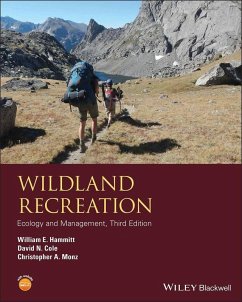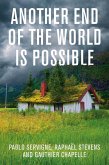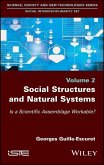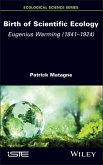Wildland Recreation (eBook, ePUB)
Ecology and Management


Alle Infos zum eBook verschenken

Wildland Recreation (eBook, ePUB)
Ecology and Management
- Format: ePub
- Merkliste
- Auf die Merkliste
- Bewerten Bewerten
- Teilen
- Produkt teilen
- Produkterinnerung
- Produkterinnerung

Hier können Sie sich einloggen

Bitte loggen Sie sich zunächst in Ihr Kundenkonto ein oder registrieren Sie sich bei bücher.de, um das eBook-Abo tolino select nutzen zu können.
WILDLAND RECREATION THE AUTHORITATIVE GUIDE TO UNDERSTANDING AND MANAGING THE ECOLOGICAL IMPACTS OF RECREATIONAL ACTIVITIES IN WILDLANDS This third edition provides an updated and thorough examination of the ecological impacts of recreational use on wildlands and the best management practices to employ in places where recreation and preservation of natural conditions are important - and often conflicting - objectives. Covering the latest research, this edition provides detailed information about the environmental changes that result from recreational use. It describes spatial patterns of…mehr
- Geräte: eReader
- mit Kopierschutz
- eBook Hilfe
- Größe: 24.9MB
![The Ecology of Sandy Shores (eBook, ePUB) The Ecology of Sandy Shores (eBook, ePUB)]() Anton McLachlanThe Ecology of Sandy Shores (eBook, ePUB)78,95 €
Anton McLachlanThe Ecology of Sandy Shores (eBook, ePUB)78,95 €![Wood (eBook, ePUB) Wood (eBook, ePUB)]() Joachim RadkauWood (eBook, ePUB)15,99 €
Joachim RadkauWood (eBook, ePUB)15,99 €![Environmental Ethics (eBook, ePUB) Environmental Ethics (eBook, ePUB)]() Robin AttfieldEnvironmental Ethics (eBook, ePUB)19,99 €
Robin AttfieldEnvironmental Ethics (eBook, ePUB)19,99 €![Another End of the World is Possible (eBook, ePUB) Another End of the World is Possible (eBook, ePUB)]() Pablo ServigneAnother End of the World is Possible (eBook, ePUB)12,99 €
Pablo ServigneAnother End of the World is Possible (eBook, ePUB)12,99 €![How Everything Can Collapse (eBook, ePUB) How Everything Can Collapse (eBook, ePUB)]() Pablo ServigneHow Everything Can Collapse (eBook, ePUB)12,99 €
Pablo ServigneHow Everything Can Collapse (eBook, ePUB)12,99 €![Social Structures and Natural Systems (eBook, ePUB) Social Structures and Natural Systems (eBook, ePUB)]() Georges Guille-EscuretSocial Structures and Natural Systems (eBook, ePUB)139,99 €
Georges Guille-EscuretSocial Structures and Natural Systems (eBook, ePUB)139,99 €![Birth of Scientific Ecology (eBook, ePUB) Birth of Scientific Ecology (eBook, ePUB)]() Birth of Scientific Ecology (eBook, ePUB)142,99 €
Birth of Scientific Ecology (eBook, ePUB)142,99 €-
-
-
Dieser Download kann aus rechtlichen Gründen nur mit Rechnungsadresse in A, B, BG, CY, CZ, D, DK, EW, E, FIN, F, GR, HR, H, IRL, I, LT, L, LR, M, NL, PL, P, R, S, SLO, SK ausgeliefert werden.
- Produktdetails
- Verlag: John Wiley & Sons
- Seitenzahl: 328
- Erscheinungstermin: 3. Februar 2015
- Englisch
- ISBN-13: 9781118396933
- Artikelnr.: 42774320
- Verlag: John Wiley & Sons
- Seitenzahl: 328
- Erscheinungstermin: 3. Februar 2015
- Englisch
- ISBN-13: 9781118396933
- Artikelnr.: 42774320
Recreation and Resource Impacts 3 1.1 What is Wildland Recreation? 3 1.2
What is Recreation Resource Impact? 6 1.3 Ecological Impacts of Wildland
Recreation 6 1.4 Recreation Ecology 9 1.5 The Importance of Ecological
Impacts 10 1.6 The Manager's Role 12 1.7 Recreational Capacities 12 1.8
Themes of this Book 14 References 16 PART II IMPACTS TO RESOURCE COMPONENTS
19 2 Soil 21 2.1 Basic Soil Ecology 21 2.1.1 What is soil? 21 2.1.2 Soil
texture and structure 21 2.1.3 Pore space 22 2.1.4 Bulk density 23 2.1.5
The soil profile 23 2.2 Effects of Recreation on Soils 24 2.2.1 Organic
matter 25 2.2.2 Profile truncation 27 2.2.3 Soil compaction 28 2.2.4
Macroporosity and infiltration rate 29 2.2.5 Soil moisture 31 2.3 Soil
Erosion 32 2.3.1 Erosion as a natural process 32 2.3.2 Recreation and
erosion 33 2.3.3 Other soil impacts 35 2.3.4 Impacts associated with
campfires 36 2.4 Summary 37 References 38 3 Vegetation 41 3.1 Vegetation
Impact Parameters 41 3.1.1 Amount of vegetation 41 3.1.2 Species
composition and other properties 43 3.1.3 Tree condition 43 3.2
Understanding Vegetation Impacts 43 3.2.1 Ground cover 44 3.2.2 Shrubs and
saplings 51 3.2.3 Mature trees 51 3.3 Summary 53 References 53 4 Wildlife
56 4.1 Recreation Influences on Wildlife Responses 56 4.2 Wildlife
Responses to Recreation 57 4.3 Human-Wildlife Interactions 58 4.4
Recreation-Wildlife Impacts 59 4.4.1 Animal disturbance and harassment 60
4.4.2 Harvest 62 4.4.3 Habitat modification 63 4.4.4 Alteration of behavior
64 4.4.5 Species displacement and reproduction level 66 4.4.6 Species
composition and structure 67 4.5 Impacts on Wildlife Species 67 4.5.1 Large
mammals 67 4.5.2 Medium-sized animals 73 4.5.3 Small animals 74 4.5.4 Fish
75 4.6 Summary 75 References 76 5 Water 80 5.1 Dispersed Recreation and
Water Impacts 80 5.2 Basic Water Ecology 81 5.2.1 Water temperature and
flow 82 5.2.2 Dissolved oxygen 83 5.2.3 Nutrient influx 83 5.2.4 Coliform
bacteria and other pathogens 85 5.3 Backcountry Camping and Drinking
Sources 88 5.4 Solid Waste and Foreign Materials 89 5.5 Suspended Matter
and Turbidity 90 5.6 Summary 93 References 93 PART III Impact patterns and
trends 97 6 Impact Patterns 99 6.1 Spatial Patterns of Impact 99 6.1.1
Impact zone 100 6.1.2 Intersite zone 101 6.1.3 Buffer zone 101 6.2 Impact
Patterns at Multiple Spatial Scales 103 6.3 Temporal Patterns of Impacts
104 6.4 Recovery Rates of Resources 108 6.5 Summary 110 References 111 7
Trends in Wildland Recreation 113 7.1 Use and Impacts 113 7.2 Early Recent
and Projected Outdoor Recreation Use 113 7.3 Trends in Wildland and
Wilderness Use 117 7.4 Trends in Wildland and Wilderness Users 120 7.4.1
Conclusions drawn from trend synthesis 122 7.5 Trends in Wildland Impacts
124 7.5.1 Trail impact trends 124 7.5.2 Campsite impact trends 125 7.6
Summary 129 References 129 PART IV FACTORS AFFECTING IMPACTS 133 8
Environmental Durability 135 8.1 Vegetation 136 8.2 Soil Characteristics
141 8.3 Topographic Characteristics 143 8.4 Ecosystem Characteristics 144
8.4.1 Wildlife 145 8.5 Aquatic Environments 146 8.6 Season of Use 146 8.7
Map-Based Analysis Approaches 147 8.8 Summary 147 References 149 9 Visitor
Use and Behavior 152 9.1 Amount of Use 153 9.2 Use Distribution 156 9.2.1
Type of use 157 9.3 Party size 157 9.4 User behavior 160 9.4.1 Minimum
impact knowledge 160 9.4.2 Experience level 163 9.4.3 User motivation 164
9.4.4 Social group and structure 164 9.5 Place Bonding 165 9.6 Mode of
Travel 167 9.6.1 Snowmobiles skis and snowboards 167 9.6.2 Motorboats
personal watercraft and nonmotorized boats 168 9.6.3 Off-road vehicles
mountain bikes stock and foot travel 169 9.7 Summary 173 References 174
PART V MANAGEMENT ALTERNATIVES 179 10 Strategies and Concepts of Management
181 10.1 General Principles 181 10.2 Planning for Management 183 10.2.1
Recreation opportunity spectrum 183 10.2.2 A visitor use management
framework 184 10.3 Management of Problems 189 10.3.1 Strategic purpose 189
10.3.2 Types of undesirable visitor actions 191 10.3.3 Types of management
approaches 191 References 194 11 Monitoring Recreational Impacts 196 11.1
Camp and Picnic Sites 196 11.1.1 Photographs 198 11.1.2 Condition class
estimates 199 11.1.3 Multiple parameter systems 200 11.2 Trails and Roads
208 11.2.1 Samples at fixed locations 208 11.2.2 Rapid survey samples 210
11.2.3 Census techniques 211 11.2.4 Informal trails 212 11.2.5 Roads and
off-road vehicle trails 214 11.3 Water Bodies 215 11.4 Wildlife 216 11.5
Developing a Monitoring System 216 References 217 12 Visitor Management 219
12.1 Use Limits 220 12.2 Length of Stay Limits 224 12.3 Dispersal of Use
225 12.4 Concentration of Use 231 12.5 Restrictions on Type of Use 232 12.6
Group Size Limits 234 12.7 Low Impact Education 236 12.7.1 Message content
236 12.7.2 Effective communication 238 12.8 Seasonal Limitations on Use 241
12.9 Campfire Management Alternatives 242 12.10 Visitor Information Needed
to Manage Recreation Impacts 244 References 245 13 Site Management 248 13.1
Locating Use on Resistant Sites 249 13.2 Permanent Closures 253 13.3
Temporary Site Closures 254 13.4 Influencing Spatial Distribution of Use
256 13.5 Site Hardening and Shielding 260 13.6 Rehabilitation of Closed
Sites 270 References 275 14 Air Sound and Technology: New Issues for
Recreation Ecology 277 14.1 Air Quality 277 14.1.1 Within-park emissions
278 14.1.2 Importance of air pollution 280 14.1.3 Night sky light
visibility 283 14.1.4 Summary and solutions 284 14.2 Natural Soundscapes
284 14.2.1 Understanding soundscapes and key ecological concerns 286 14.2.2
Impacts of noise on visitor experiences in wildlands 288 14.2.3 Assessment
and monitoring of soundscapes 290 14.2.4 Summary and solutions 291 14.3
Technology 291 14.3.1 Improved technology 291 14.3.2 New recreational
activities 292 14.3.3 Electronic technology 293 14.3.4 Summary and
solutions 295 References 295 PART VI Conclusion 297 15 A Lasting Impact 299
15.1 Wildland Recreation and Resource Impacts: Necessities 299 15.2
Understanding the Resource 300 15.3 Environment and Visitor Influences 300
15.4 Some Management Tools 301 15.5 New Issues and Knowledge 302 15.6
Lasting into the Future 303 References 305 Index 306
Recreation and Resource Impacts 3 1.1 What is Wildland Recreation? 3 1.2
What is Recreation Resource Impact? 6 1.3 Ecological Impacts of Wildland
Recreation 6 1.4 Recreation Ecology 9 1.5 The Importance of Ecological
Impacts 10 1.6 The Manager's Role 12 1.7 Recreational Capacities 12 1.8
Themes of this Book 14 References 16 PART II IMPACTS TO RESOURCE COMPONENTS
19 2 Soil 21 2.1 Basic Soil Ecology 21 2.1.1 What is soil? 21 2.1.2 Soil
texture and structure 21 2.1.3 Pore space 22 2.1.4 Bulk density 23 2.1.5
The soil profile 23 2.2 Effects of Recreation on Soils 24 2.2.1 Organic
matter 25 2.2.2 Profile truncation 27 2.2.3 Soil compaction 28 2.2.4
Macroporosity and infiltration rate 29 2.2.5 Soil moisture 31 2.3 Soil
Erosion 32 2.3.1 Erosion as a natural process 32 2.3.2 Recreation and
erosion 33 2.3.3 Other soil impacts 35 2.3.4 Impacts associated with
campfires 36 2.4 Summary 37 References 38 3 Vegetation 41 3.1 Vegetation
Impact Parameters 41 3.1.1 Amount of vegetation 41 3.1.2 Species
composition and other properties 43 3.1.3 Tree condition 43 3.2
Understanding Vegetation Impacts 43 3.2.1 Ground cover 44 3.2.2 Shrubs and
saplings 51 3.2.3 Mature trees 51 3.3 Summary 53 References 53 4 Wildlife
56 4.1 Recreation Influences on Wildlife Responses 56 4.2 Wildlife
Responses to Recreation 57 4.3 Human-Wildlife Interactions 58 4.4
Recreation-Wildlife Impacts 59 4.4.1 Animal disturbance and harassment 60
4.4.2 Harvest 62 4.4.3 Habitat modification 63 4.4.4 Alteration of behavior
64 4.4.5 Species displacement and reproduction level 66 4.4.6 Species
composition and structure 67 4.5 Impacts on Wildlife Species 67 4.5.1 Large
mammals 67 4.5.2 Medium-sized animals 73 4.5.3 Small animals 74 4.5.4 Fish
75 4.6 Summary 75 References 76 5 Water 80 5.1 Dispersed Recreation and
Water Impacts 80 5.2 Basic Water Ecology 81 5.2.1 Water temperature and
flow 82 5.2.2 Dissolved oxygen 83 5.2.3 Nutrient influx 83 5.2.4 Coliform
bacteria and other pathogens 85 5.3 Backcountry Camping and Drinking
Sources 88 5.4 Solid Waste and Foreign Materials 89 5.5 Suspended Matter
and Turbidity 90 5.6 Summary 93 References 93 PART III Impact patterns and
trends 97 6 Impact Patterns 99 6.1 Spatial Patterns of Impact 99 6.1.1
Impact zone 100 6.1.2 Intersite zone 101 6.1.3 Buffer zone 101 6.2 Impact
Patterns at Multiple Spatial Scales 103 6.3 Temporal Patterns of Impacts
104 6.4 Recovery Rates of Resources 108 6.5 Summary 110 References 111 7
Trends in Wildland Recreation 113 7.1 Use and Impacts 113 7.2 Early Recent
and Projected Outdoor Recreation Use 113 7.3 Trends in Wildland and
Wilderness Use 117 7.4 Trends in Wildland and Wilderness Users 120 7.4.1
Conclusions drawn from trend synthesis 122 7.5 Trends in Wildland Impacts
124 7.5.1 Trail impact trends 124 7.5.2 Campsite impact trends 125 7.6
Summary 129 References 129 PART IV FACTORS AFFECTING IMPACTS 133 8
Environmental Durability 135 8.1 Vegetation 136 8.2 Soil Characteristics
141 8.3 Topographic Characteristics 143 8.4 Ecosystem Characteristics 144
8.4.1 Wildlife 145 8.5 Aquatic Environments 146 8.6 Season of Use 146 8.7
Map-Based Analysis Approaches 147 8.8 Summary 147 References 149 9 Visitor
Use and Behavior 152 9.1 Amount of Use 153 9.2 Use Distribution 156 9.2.1
Type of use 157 9.3 Party size 157 9.4 User behavior 160 9.4.1 Minimum
impact knowledge 160 9.4.2 Experience level 163 9.4.3 User motivation 164
9.4.4 Social group and structure 164 9.5 Place Bonding 165 9.6 Mode of
Travel 167 9.6.1 Snowmobiles skis and snowboards 167 9.6.2 Motorboats
personal watercraft and nonmotorized boats 168 9.6.3 Off-road vehicles
mountain bikes stock and foot travel 169 9.7 Summary 173 References 174
PART V MANAGEMENT ALTERNATIVES 179 10 Strategies and Concepts of Management
181 10.1 General Principles 181 10.2 Planning for Management 183 10.2.1
Recreation opportunity spectrum 183 10.2.2 A visitor use management
framework 184 10.3 Management of Problems 189 10.3.1 Strategic purpose 189
10.3.2 Types of undesirable visitor actions 191 10.3.3 Types of management
approaches 191 References 194 11 Monitoring Recreational Impacts 196 11.1
Camp and Picnic Sites 196 11.1.1 Photographs 198 11.1.2 Condition class
estimates 199 11.1.3 Multiple parameter systems 200 11.2 Trails and Roads
208 11.2.1 Samples at fixed locations 208 11.2.2 Rapid survey samples 210
11.2.3 Census techniques 211 11.2.4 Informal trails 212 11.2.5 Roads and
off-road vehicle trails 214 11.3 Water Bodies 215 11.4 Wildlife 216 11.5
Developing a Monitoring System 216 References 217 12 Visitor Management 219
12.1 Use Limits 220 12.2 Length of Stay Limits 224 12.3 Dispersal of Use
225 12.4 Concentration of Use 231 12.5 Restrictions on Type of Use 232 12.6
Group Size Limits 234 12.7 Low Impact Education 236 12.7.1 Message content
236 12.7.2 Effective communication 238 12.8 Seasonal Limitations on Use 241
12.9 Campfire Management Alternatives 242 12.10 Visitor Information Needed
to Manage Recreation Impacts 244 References 245 13 Site Management 248 13.1
Locating Use on Resistant Sites 249 13.2 Permanent Closures 253 13.3
Temporary Site Closures 254 13.4 Influencing Spatial Distribution of Use
256 13.5 Site Hardening and Shielding 260 13.6 Rehabilitation of Closed
Sites 270 References 275 14 Air Sound and Technology: New Issues for
Recreation Ecology 277 14.1 Air Quality 277 14.1.1 Within-park emissions
278 14.1.2 Importance of air pollution 280 14.1.3 Night sky light
visibility 283 14.1.4 Summary and solutions 284 14.2 Natural Soundscapes
284 14.2.1 Understanding soundscapes and key ecological concerns 286 14.2.2
Impacts of noise on visitor experiences in wildlands 288 14.2.3 Assessment
and monitoring of soundscapes 290 14.2.4 Summary and solutions 291 14.3
Technology 291 14.3.1 Improved technology 291 14.3.2 New recreational
activities 292 14.3.3 Electronic technology 293 14.3.4 Summary and
solutions 295 References 295 PART VI Conclusion 297 15 A Lasting Impact 299
15.1 Wildland Recreation and Resource Impacts: Necessities 299 15.2
Understanding the Resource 300 15.3 Environment and Visitor Influences 300
15.4 Some Management Tools 301 15.5 New Issues and Knowledge 302 15.6
Lasting into the Future 303 References 305 Index 306







